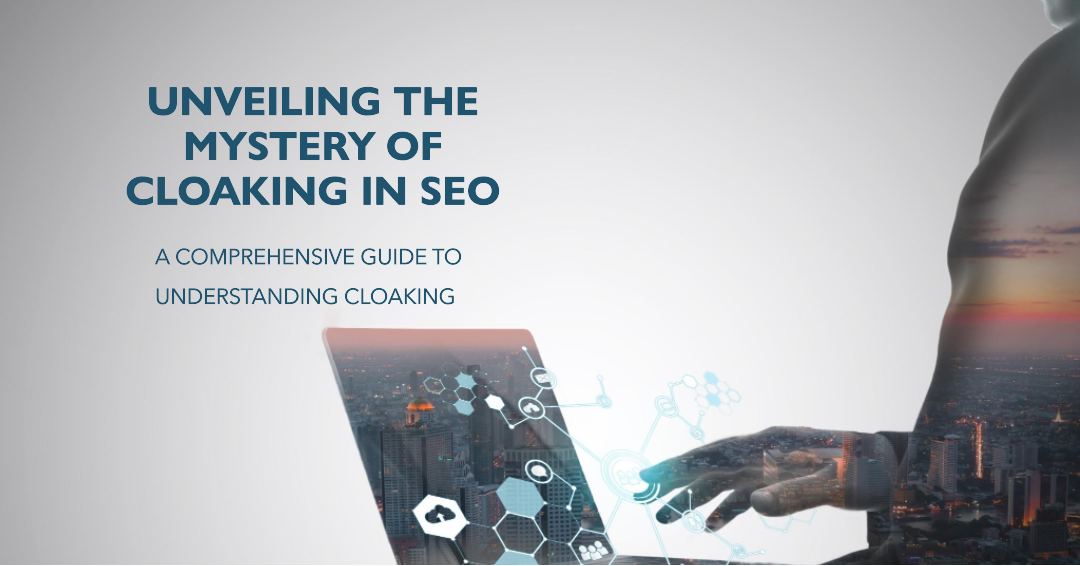Unlock the Secrets of SEO Cloaking! Discover what cloaking in SEO truly means and how it impacts your website's visibility. Get the scoop on ethical practices and potential pitfalls.
In the ever-evolving landscape of search engine optimization (SEO), various techniques and strategies emerge to improve a website's visibility and ranking on search engine results pages (SERPs). One such technique that has garnered both curiosity and controversy is "cloaking." In this comprehensive guide, we'll unravel the mysteries of what is cloaking in SEO, exploring what it is, how it works, its potential benefits, ethical concerns, and its impact on website performance.
In the complex world of SEO, strategies to manipulate search engine rankings continually evolve. One such strategy, cloaking, has been a topic of debate for years. Cloaking involves presenting different content or URLs to search engines and human users, and it can be a double-edged sword in the SEO arsenal.
Definition and Basics| What is cloaking in SEO?
Cloaking, in its essence, is the practice of displaying different content to search engine crawlers and human visitors. This means that when a search engine bot scans a webpage, it sees content that is different from what a human user sees. The goal of cloaking is to deceive search engines into ranking a page higher than it deserves.
How Cloaking Works?
Cloaking operates through various techniques, with IP-based cloaking, user-agent cloaking, and JavaScript cloaking being the most common. IP-based cloaking targets specific IP addresses, serving tailored content based on the origin of the visitor. User-agent cloaking customizes content based on the type of device or browser used. JavaScript cloaking dynamically alters content after the initial page load.
Types of Cloaking
1. IP-Based Cloaking
IP-based cloaking is primarily used for geo-targeting. It ensures that visitors from different regions see content that is relevant to their location, improving user experience and engagement.
2. User-Agent Cloaking
User-agent cloaking tailors content for different devices, ensuring that mobile users receive a mobile-friendly version of the website, while desktop users get an optimized view.
3. JavaScript Cloaking
JavaScript cloaking dynamically changes content using client-side scripts. It can be used to load additional information or interactive elements for human users.
The Purpose of Cloaking
Cloaking serves various purposes in SEO, including enhancing user experience, geo-targeting, and mobile optimization.
Benefits and Advantages
1. Enhanced User Experience
By delivering content that matches a user's preferences and device, cloaking can significantly enhance the overall user experience, leading to lower bounce rates and longer visit durations.
2. Geo-Targeting
For businesses with a global reach, geo-targeting through cloaking allows them to display location-specific content, promotions, and contact details, making their websites more relevant to local audiences.
3. Mobile Optimization
In an era where mobile browsing is prevalent, user-agent cloaking ensures that mobile users see content that is tailored to their devices, promoting mobile-friendliness.
Cloaking vs. Black Hat SEO
1. Ethical Concerns
While cloaking can offer benefits, it also raises ethical concerns. Search engines consider cloaking deceptive, as it misleads both users and bots.
2. Search Engine Guidelines
All major search engines strictly prohibit cloaking. Websites caught employing cloaking techniques risk severe penalties, including deindexing from search engine results.
The Risks of Cloaking
1. Penalties and Deindexing
The consequences of cloaking can be severe. Search engines actively combat cloaking, and websites employing these techniques often face penalties, including removal from search engine results.
2. User Trust
Cloaking erodes user trust, as visitors may feel deceived when they discover discrepancies between the content they saw on the SERPs and the content on the actual webpage.
Cloaking in Practice
1. Use Cases
Cloaking is sometimes used by websites to deliver a personalized experience to users based on their location, device, or preferences.
2. Tools and Technologies
Various tools and technologies are available to implement cloaking, but their usage should adhere to ethical guidelines.
Best Practices for Ethical Cloaking
To use cloaking ethically, adhere to best practices such as transparency, user-centric content, and compliance with search engine guidelines.
The Future of Cloaking in SEO
As search engines become more sophisticated, the future of cloaking in SEO remains uncertain. It is imperative for SEO practitioners to stay updated on industry developments.
Final Lines
Cloaking in SEO is a contentious strategy with the potential for benefits but also significant risks. Understanding its nuances, ethical considerations, and potential consequences is vital for making informed decisions about its use.
FAQs
Q.1 Is cloaking illegal?
A. Cloaking is not illegal, but it violates search engine guidelines and can lead to penalties.
Q.2 Can cloaking boost SEO rankings?
A. Cloaking can temporarily boost rankings, but the risks of penalties and loss of user trust outweigh the benefits.
Q.3 How can I implement cloaking ethically?
A. To implement cloaking ethically, focus on user-centric content, transparency, and compliance with search engine guidelines.
Q.4 Are there alternatives to cloaking for SEO?
A. Yes, there are legitimate SEO strategies that do not involve cloaking, such as on-page optimization, content marketing, and link building.
Q.5 What are the common misconceptions about cloaking?
A. Common misconceptions include the belief that cloaking is a guaranteed SEO shortcut and that it can go unnoticed by search engines.

